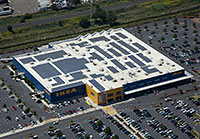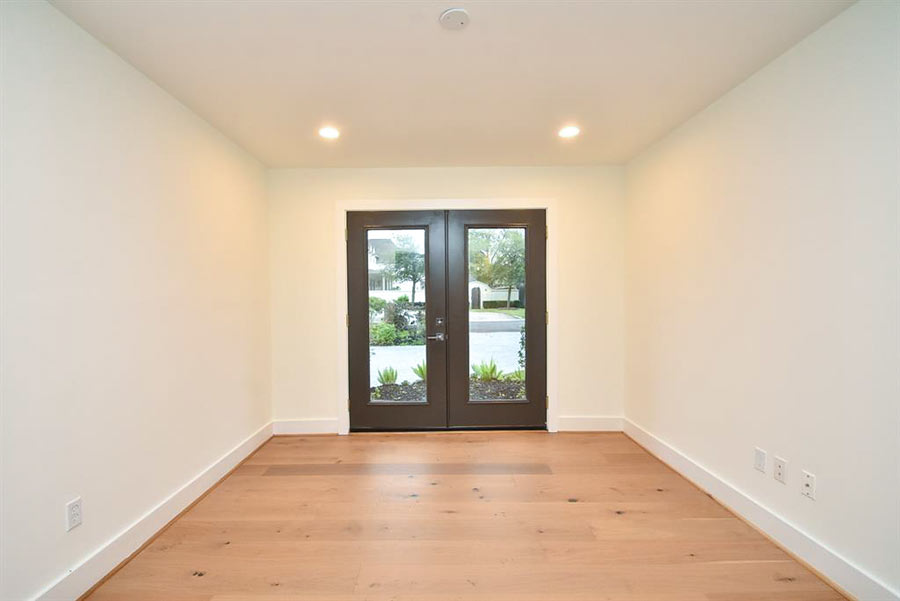HOUSTON IKEA GOING SOLAR  Houston’s 300,000-sq.-ft. IKEA store on the Katy Fwy. near Antoine — along with 8 other southern-state locations and a distribution center — will soon be covered with rooftop solar panels. The furniture company’s U.S. solar program began late last year. Contractor REC Solar will install 3,962 PV panels measuring a total of approximately 116,400 sq. ft., which IKEA will own and operate, on top of the Houston store by next summer. A company press release estimates the Houston panels will produce 931 kW, for a projected annual electricity output of 1,317,500 kWH per year. [BusinessWire] Photo of panels installed earlier this year in West Sacramento: IKEA
Houston’s 300,000-sq.-ft. IKEA store on the Katy Fwy. near Antoine — along with 8 other southern-state locations and a distribution center — will soon be covered with rooftop solar panels. The furniture company’s U.S. solar program began late last year. Contractor REC Solar will install 3,962 PV panels measuring a total of approximately 116,400 sq. ft., which IKEA will own and operate, on top of the Houston store by next summer. A company press release estimates the Houston panels will produce 931 kW, for a projected annual electricity output of 1,317,500 kWH per year. [BusinessWire] Photo of panels installed earlier this year in West Sacramento: IKEA





That isnt very much electricity
@Benny Cargill
As a person that works in the utility and renewable industry…you’re right, its not very much electricity. Unless IKEA is getting MAJOR utility rebates or government tax incentives, solar panels are a terrible investment. However, they’ll make you look green while you air condition 300,000 sqft…
Sounds like a 10-15 year payback. Not great…
How does 937 kW translate into 1,317,500 kWH/yr? Maybe someone could do the math.
931 kW With a capacity factor of what? 30-40 percent? Makes it even a worse investment than already stated…
Sometimes upgrades like this are not so much as an investment or tool to lower cost for the building owner, they are for generally lowering energy reliance and consumption on a system that waste our earth’s resources. That’s where the real benefit is!!!
I’m sure Ikea Management did the math and realize it’s not going to be a good investment. I guess they are trying to be more green…get good PR…and hopefully be a role model for other businesses in Houston. I think they’ll accomplish that. But save money? Not anytime soon.
I say, WAY TO GO!
IKEA’s a wealthy company that can afford this solar investment. I say Hooray! because it’s another effort toward fossil fuel independence. Solar is here to stay.
“Going green” is definitely a marketing angle these days and is made more powerful by something visible. There are a lot of conscious/sensitive/guilt ridden customers who want to spend at such places.
Didn’t you guys see the article about rolling blackouts again next summer?
Decentralizing electricity production is a brilliant idea. Do your break even periods include any significant growth rate in energy costs? Traditional electricity will only be more expensive in the future.
I agree with Movocelot: Hooray!
Hell, if you’re going to build elaborate financial spiderwebs to avoid paying taxes, you might as well spend some of that money you save on solar panels.
at current prices this project will probably take 12-15 years to pay itself off. If prices increase any it only reduces that time. As more and more of these types of projects happen, it will only decrease the cost of going solar. Power behind the meter is the way of the future.
According to the article, this is just one of many solar projects for IKEA in the US. If they leverage their purchasing power, they should be able to get a very good price for the solar arrays. That means a shorter time period to recoup the investment. They may also save money on backup generators for critical systems.
The people above saying this is a bad investment, can you tell us why or the numbers to back what you are saying? I’ve looked at residential solar numbers and they are not bad, they break even at worst in 10 years, taking into account the tax credit, property tax deduction and utility net metering. It even looks a lot better considering the trend that electricity rates may go after last summer and winter rolling blackouts. Also, solar produces power exactly when it is most needed, so Reliant and ERCOT might appreciate that and kick in extra $, but this is me speculating.
Btw, 931 Kw. That’s almost a megawatt (MW). Most people in the know estimate a MW powers between 500 and 1000 homes. It doesn’t seem cooling Ikea would take that much, but I could be wrong.
I applaud the Swedes. Pretty sure they will be there for another 20+ years.
Yes Jose, you are wrong. It takes a little over 17 MWs to power a local High School of 300,000 square feet that I recently studied. I’d speculate IKEA uses much more than a High School, because of its longer hours of operation. This solar array probably produces less than 5% of the total electricity use of IKEA, yet it takes up the entire roof. I’m not saying that solar power is bad…it’s good and it can work well where applicable. But I just don’t like it when people actually believe that solar will be able to produce the amount of energy that is needed for our way of life any time soon. It wont. But cheers to being being proactive and “investing” in the future.
DarlingGuy, I think you meant to say 17 MWh (note the added “h”), not MW. MWh is an energy unit, MW is a power unit. Was it 17 MWh consumed monthly? The Ikea solar cell is 931 kW (no “h”). Those are power units. For some perspective, in the midst of the last very hot summer my power bill came to about 1900 kWh in a month. The Ikea solar cell will be able to generate that in about 2 hrs (1900 divided by 931). It’s not in the league of a gas-fired or coal-fired power plant, but the potential is huge if this is extended to other big box retailers or anybody with large roofs. If it breaks even on home solar, with the economies of scale, solar has got to be even more attractive to the Ikea’s of the world. The bad thing about solar is that it is only economic with the tax credit, which is really a subsidy.
No, I meant MW’s. It takes 17 MW’s to Power that high school at its peak. So those solar panels can only produce about 5% of the needed power for the high school. Sorry, I jumped to consumption in my head (kWh) without typing that out above. That same high school consumed over 9 Million kWh per year, but I would assume that an IKEA would consume more kWh per year due to the longer hours, and possibly more MW’s to run all the lights and large AC units. The point is that no, it is not a fix for anything. IKEA is going to fill up its entire roof with solar panels and produce a fraction of its needed electricity, both power (kW) and consumption (kWh). On top of that it only makes financial sense with a subsidy.
1) The electricity amount is irrelevant. What better option is there for using their rooftop real estate?
2) All energy projects are subsidized. The main differences with solar is that homes and businesses can access energy subsidies generally reserved for much larger corporations who work further upstream.
3) Assuming an install cost of $2.50/W, an effective generation rate of $0.08/kwh, the Fed ITC of 30%, and depreciation, the project has 12 year payback on a 25 year warranty. It’s not great investment, but its a secure, has markting benefits, and increases the resale value of their building. Also, I imagine the recession has curtailed IKEA expansion, which implies IKEA is running out of depreciable assets.
4) Most state and local incentives are giant wastes of money, but Houston has none. In fact, it is the largest US city without a net-metering policy, and as such you can’t eliminate your electric bill with 100% on-site power generation in Houston anyway.
Don’t hate, educate!
Even if the array does between 5%-30% of IKEA’s total energy use, PV is
Only someone called SolarWonk would say something like this.
If the electricity amount is irrelevant then I guess it really doesn’t matter how much we pay for electricity. We could build billion dollar solar panels to charge our cell phones.
Jgriff, IKEA could afford to build a giant solar farm equal to their total energy use. But it is more cost-effective for them to put the array on the roof, where they avoid real estate, site security, and dirt work costs, while putting their roof to work. Their goal isn’t to go 100%, but rather to use what resources they have on hand.
Furthermore, in Houston, outflow is credited at 3-4 cents per kwh instantaneously. As such, you can’t do 100% production in Houston.
IKEA is being practical in their solar design, doing the most that they can with respect to local energy policy, unlike your peculiar billion dollar solar module cell phone charging station proposal.
Even though I can’t budget 80% – 100% of my paycheck for retirement, I still put what I can into my IRA.
If a bond pays 4%, I’ll still get 4% regardless if I buy $100 or $1000.
The amount of electricity generated IN RELATIONSHIP TO IKEAS TOTAL ENERGY USE is irrelevant to their project payback. They’re using what rooftop space they have.